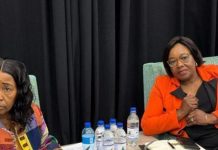Africa-Press – Namibia. A 22-year-old graduate has made history as the first San learner from Hainyeko Combined School in the Oshikunde Circuit to be admitted to university and successfully graduate.
Johanna Kamati recently obtained her Diploma in Junior Primary Education from the International University of Management (IUM) in Nkurenkuru, becoming a symbol of hope for many San learners across Namibia.
Few San students reach secondary education, and even fewer make it to tertiary level.
Hainyeko Combined School was constructed specifically to cater for San and other marginalised learners, providing them with access to education and a safe learning environment in the Ohangwena region.
“Coming from a community where people believe San people can’t be successful, I put in all my efforts to prove that nothing is impossible,” Kamati said proudly.
Kamati described her journey as one filled with hardships, but ultimately rewarding.
She said it feels amazing to achieve what many thought was impossible. “It’s a great accomplishment not only for but, for my community,” she said.
A journey against the odds
Growing up, Kamati faced numerous challenges from poverty to discrimination.
She recalls walking long distances to school, sometimes without proper uniform.
“It was not easy. I was bullied and criticised because of my tribe and my skin colour, but I never allowed that to stop me.
I knew what I wanted in life,” she said.
Despite the stigma attached to her community, Kamati believes all learners, regardless of their background, have the same potential.
She indicated that there is no difference between them and others.
“I have noticed that many San children drop out of school due to bullying and lack of support. Some feel discouraged when they are criticised by other learners. Others believe they are not meant to succeed, even when they attend school,” she explained.
She added that to change this, Kamati called for stronger mentorship, community encouragement, and financial support to help San learners stay in school and take their education seriously.
The principal’s viewpoint
Sebbron Ngololo, principal of Hainyeko Combined School, described Kamati as one of his most outstanding former learners.
“Our school mainly caters for San and other marginalised children. Kamati was one of the brightest learners we ever had, and she’s the only one who managed to go to university and graduate. Most of the others drop out along the way,” he stated.
He said Kamati’s success proves that the school’s efforts are not in vain. “She’s an inspiration to both the learners and teachers. Her achievement gives hope to others who come after her,” he said.
Ngololo explained that one of the biggest challenges is that Hainyeko Combined School only offers classes up to Grade 9.
“We once requested the Ministry of Education to extend the curriculum to higher grades so that learners could continue their education in an environment where they feel safe and supported,” he said.
He added that when San learners are transferred to other schools, they often struggle to adapt.
He said they feel unwanted or isolated because other learners don’t understand them, which leads many to drop out.
Ngololo also highlighted serious challenges at the school’s community hostel. “We face food shortages, lack of bedding, and limited space. Some learners must share beds because we don’t have enough resources,” he added.
San people in Namibia
The San people, often referred to as Bushmen, are among the most marginalised communities in Namibia. Traditionally hunter-gatherers, they have faced centuries of displacement, discrimination, and poverty.
Today, many San families live in remote areas with limited access to education, healthcare, and job opportunities.
Although government initiatives promote inclusive education, San learners often face social isolation, bullying, and financial hardships that force them out of school early.
For More News And Analysis About Namibia Follow Africa-Press






